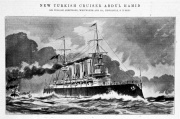Armstrong Whitworth: Shipbuilding




Note: This is a sub-section of Armstrong Whitworth.
1898 Two Russian ice-breakers were completed with 'Sampo' (1339/98) being fitted with hydraulic elevators for raising and lowering carriages and trucks for the different levels of the river Volga.
1899 'Baikal' (4200/99) was considered to be the most spectacular ship for the Russians. It was a train ferry and was sent overland in 7200 pieces and reassembled on the banks of Lake Baikal as part of the Trans-Siberian Railway!
Over 35 dry-cargo liners were also ordered from the Armstrong Mitchell yard by German and British owners between 1880 and 1913. The yard was willing to tackle anything that came its way including coastal passenger steamers, cable layers, large cargo ships, suction dredgers and floating cranes.
1899 See 1899 Shipbuilding Statistics for detail of the tonnage produced.
1911 Chinese cruiser 'Chao Ho'.
1920 The deep-water berth at Walker Naval yard was used many times for repairs, refits and modernisation of various vessels in the early 20s. This included various passenger ships notably 'Mongolia'(16385/23) which sailed for P&O between Australia via India. The ship was turbine powered and had a fixed swimming pool, an electric lift and electric heaters in cabins. Mongolia had room for 1593 passengers.
1922 The world’s largest floating dock was built for the Southampton Docks of the Southern Railway Company with five sections coming from the Naval Yard. In addition two end sections came from the Low Walker yard. The Naval Yard also produced four heavy lift ships, four general cargo ships, a Channel Ferry, two small Great Lakes traders, three lightships and a survey and buoy tender for the Nigerian Government.
The main output was tankers with twenty being completed between 1921-28.
The Naval Yard only received one order for a warship in the 1920s.
1924 Advert as shipbuilders, steelmakers, locomotive builders, civil and general engineers and more.
The Low Walker Yard completed a variety of ships including the newsprint carriers 'Humber Arm' (5758/25) and 'Corner Brook' (5759/25). These ships were to be for the newsprint trade between Newfoundland and New York. They were part of a larger project, which lead to the downfall of Armstrong, Whitworth & Co. Ltd itself.
1929 The group suffered heavy losses[1]. Two private companies were formed: Sir W G Armstrong Whitworth and Company (Engineers) Ltd, and Sir W. G. Armstrong Whitworth and Company (Shipbuilders) Ltd; the latter took over the the Devon, Walker and Tyne Iron shipyards. The holding company was renamed Armstrong Whitworth Securities Company Ltd[2].
1934 The shipyards of Sir W. G. Armstrong Whitworth and Co. (Shipbuilders) Ltd. (at Walker, Newcastle-upon-Tyne) were solely concerned with the building of mercantile craft. By this date Armstrong Whitworth had built well over 1,000 vessels, of which 900 were merchant ships. The yards had capacity for 90,000 gross tons per annum.

































